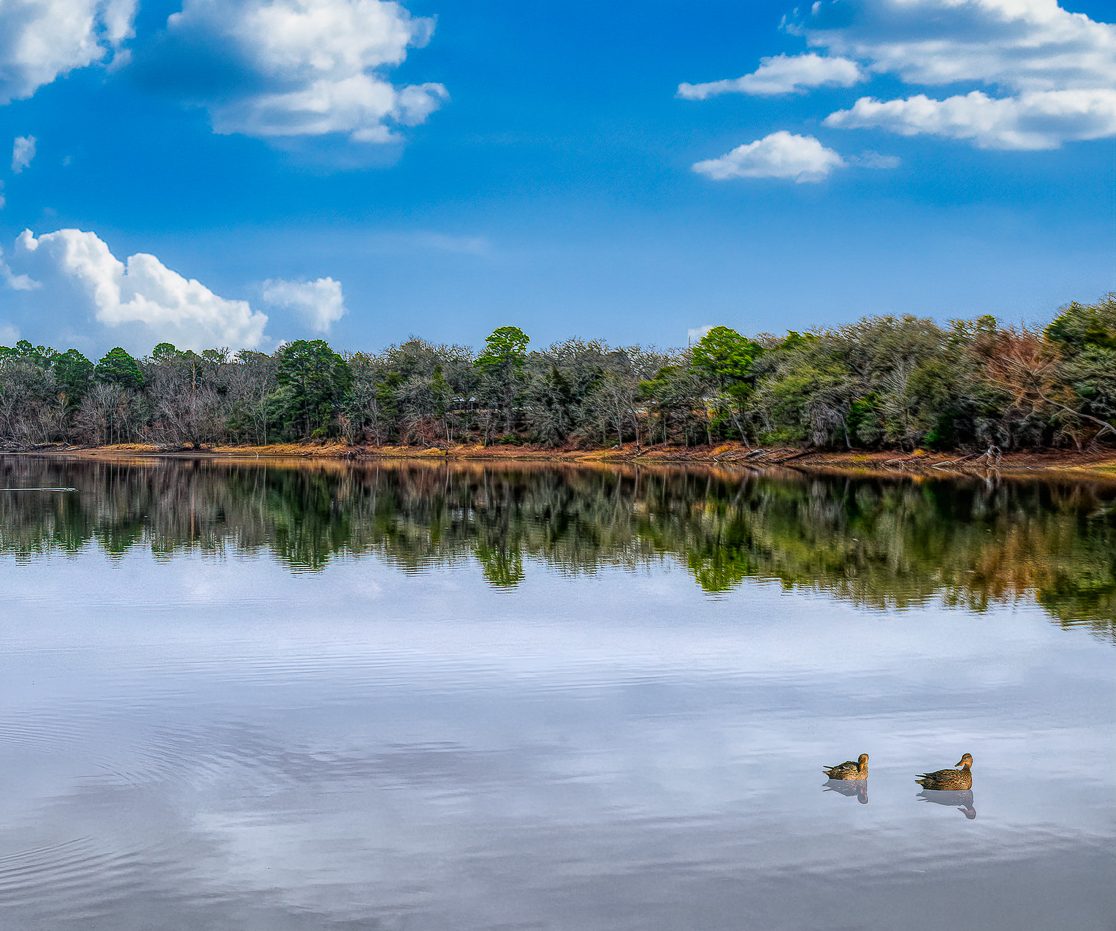
Bastrop State Park in East Texas. Photo courtesy G. Lamar Yancy via Flickr, CC BY 2.0
The Texas State Parks system marks its 100th anniversary this year. With 89 parks, natural areas, and historic sites to choose from, visitors can experience all kinds of outdoor activities. Each month, we’re highlighting one of these activities based on the season and special occasions around the state.
Usually, December in Texas is mild enough for tent camping, but our family happened to book a weekend in Bastrop State Park with a biting cold that nipped at my kids toes through their heavy boots and woolen socks. The frigid wind chilled our steaming pot of sopa de lima almost as soon as we ladled it into our bowls. We went from one extreme to another by visiting Bastrop’s sibling state park, Buechser, in the last lulling days of summer, spending our afternoon learning about bats from the interpretive guide and crafting cute hanging bats made out of toilet-paper rolls in the comfort of the air conditioned recreation hall. Despite a vast difference in climate, both weekends made us want to return.
These sister state parks sit off State Highway 71, less than an hour from Austin and about a two-hour drive from Houston. Tucked away in the Lost Pines of Texas, marked by a proliferation of loblolly pines, both parks share the ecological wonders unique to the Post Oak Savannah, such as the pileated woodpecker and the endangered Houston toad. Without much ambition, anyone willing to traverse the bikeable (and driveable) park road 1C, which connects the parks via a scenic 12-mile stretch, can easily enjoy both parks in a single weekend. Even a single day, though the beauty of the parks’ collective 7,617 acres deserves as much attention as you have time to give it.
The parks hit the trifecta of family-friendly park adventures: proximity to several major Texas cities, manageable hikes for even the smallest visitors, and accessible overnight accommodations. Collectively, the parks have everything from primitive walk-in campsites to both historic and newly built cabins (with A/C!). The parks share a robust events calendar, which includes the Bastrop Field & Fun Fest celebrating 100 years of Texas State Parks, Predators of the Pines guided hikes, and monthly readings with Ranger Madelyn at the Smithville Public Library.
In summer months, visitors can enjoy the pool at Bastrop, and anyone with a day pass to the park can enjoy fishing for bass, catfish, and sunfish year-round in Bastrop’s half-acre Lake Mina. The Buescher State Park Lake, which has been closed for construction, still promises to reopen sometime this year, and additionally offers fishers the opportunity to catch crappie, perch, and rainbow trout during the winter. A training in November (registration is open through Oct. 27)can help avid campers develop skills to teach beginners how to navigate a weekend in the woods through the Texas Outdoor Family program.
A combined 13 miles of trails weave through the Post Oak Savannah, dangling 100 miles away from the East Texas pines. Pollen records date the pines back 18,000 years. The tapestry of flora, which Texas Parks & Wildlife describes as “a mosaic of pines, oaks, shrubs, grassland, and mixed flowering plants,” provides an ideal environment for squirrels, rabbits, opossums, armadillos, and white-tailed deer. Birders can use the extensive bird checklist to help guide them to find some of the 250 species of birds that have been identified across the parks.
For ambitious hikers there is the 8.2-mile Lost Pines Loop in Bastrop, and the 4-mile Pine Gulch Trail in Buescher, traversing through much of the park. If you’re looking to enjoy the scenery on an abridged version, do what our family did and use the Barred Owl Path to abbreviate the Pine Gulch Trail. Here, you find the 1.7-mile Scenic Overlook Trail at Bastrop. While the views were enticing enough for my husband and 10-year-old, we dropped change scrounged from our car’s console to lure my 4-year-old to keep going. For her, the hike was marked by shiny treasures found along the path; for us it was the native wildlife. The bracken ferns along Scenic Overlook Trail have fossil records dating back 55 million years ago. While on the trail, take a moment to pause at the Civilian Conservation Corps water tower to absorb the view.
Many will remember the 2011 wildfires, which damaged 96% of Bastrop State Park. The resilient and iconic loblolly pines of the area, which have adapted as the climate has become drier to require 30% less water than their East Texas relatives, are making a formidable comeback. Still, it must be noted that burn bans are frequently in effect (check the websites for the most up-to-date park alerts). For overnight campers this means amending plans to work around the ban on charcoal or wood fires (containerized fuel stoves are still allowed for cooking).
In the evening, we sat on the deck wrapping around our cabin in Buescher, with its encompassing views of the landscape around us. We honed our gazes to bird sightings, straining our ears to hear their calls, and trying to train ourselves to capture the flitting creatures in the lens of the binoculars. As the world bustled around us, our entertainment and enjoyment returned to its most primitive state. Bastrop and Buescher provide a refuge not only for nature to thrive, but for humans to thrive in nature.








